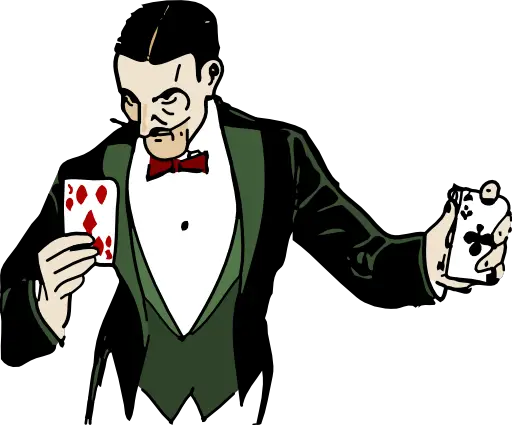Support our educational content for free when you purchase through links on our site. Learn more
10 Ways Magicians Use Science 🤯
Have you ever watched a magician and wondered, “How did they do that?!” It’s not just sleight of hand and misdirection; it’s a masterful blend of science and showmanship! In this article, we’ll reveal the 10 key ways magicians use science – from exploiting the laws of physics to manipulating your very perception – to create illusions that defy belief. We’ll explore the psychology of wonder, the physics of deception, and the role of technology in modern magic. Prepare to be amazed (and maybe a little enlightened)! Did you know that even a simple card trick can involve principles of probability and statistics? We’ll uncover the secrets behind the magic, revealing the scientific principles that make these incredible feats possible. Get ready to see magic in a whole new light!
Key Takeaways
- Magicians master misdirection: They expertly control your attention, drawing your focus away from the real action.
- Sleight of hand is a science: Years of practice are needed to master the precise movements and dexterity required.
- Optical illusions are a magician’s best friend: They use visual tricks to make things appear or disappear, change size, or defy gravity.
- Technology plays a significant role: From hidden electronics to sophisticated lighting, technology enhances the illusion.
- Psychology is key: Magicians understand and exploit cognitive biases and attentional limitations to create wonder.
Want to learn more and try some tricks yourself? Check out our selection of magic supplies:
- Theory11 Playing Cards: Amazon | Theory11 Official Website
- Penguin Magic: Amazon | Penguin Magic Official Website
- Murphy’s Magic Supplies: Amazon | Murphy’s Magic Official Website
Table of Contents
A Brief History of Magic and its Scientific Roots
1. The Physics of Deception: How Magicians Exploit Physical Laws
2. The Psychology of Wonder: Understanding the Audience’s Mind
3. Mastering Misdirection: The Art of Controlled Attention
4. Sleight of Hand: The Science of Dexterity and Deception
5. Optical Illusions: Exploiting the Eye’s Limitations
6. The Role of Technology in Modern Magic
7. Props and Gadgets: Tools of the Trade
8. Showmanship and Stagecraft: The Performance Aspect
9. The Ethics of Magic: Revealing Secrets Responsibly
10. Learning the Art of Illusion: Resources and Training
Quick Tips and Facts
Let’s start with some mind-blowing facts about how magicians use science! Did you know that many seemingly impossible feats rely on principles of physics, psychology, and even technology? 🤔 We’re talking about more than just rabbit-from-a-hat stuff; we’re talking about manipulating perception, exploiting cognitive biases, and using clever engineering.
- Misdirection is key: Magicians expertly control your attention, drawing your focus away from the real action. It’s not about deception, it’s about controlled distraction.
- Sleight of hand is a science: Years of practice are needed to master the precise movements and dexterity required for many illusions. It’s like a finely-tuned machine! ⚙️
- Optical illusions are your enemy (and your friend!): Magicians use visual tricks to make things appear or disappear, change size, or even defy gravity.
- Technology plays a role: From hidden electronics to sophisticated lighting, technology enhances the illusion. Think lasers, hidden cameras, and even apps! 📱
Want to learn more about a specific scientific magic trick? Check out this related article: Scientific Magic Trick
A Brief History of Magic and its Scientific Roots
Believe it or not, magic and science have been intertwined for centuries! Early magicians, often seen as mystics or healers, used their knowledge of natural phenomena – herbs, astronomy, and even basic physics – to create awe-inspiring displays. Think of ancient rituals and ceremonies; many incorporated elements that we now understand through a scientific lens. The line between “magic” and “science” was often blurry, with practitioners often blending the two.
Over time, the focus shifted. The development of scientific understanding led to a more methodical approach to illusion. Magicians began to study human perception and exploit cognitive biases, creating increasingly sophisticated illusions. The rise of stage magic in the 19th and 20th centuries saw the incorporation of engineering and technology, leading to the spectacular illusions we see today. Think of the great escape artists like Harry Houdini – his escapes were not just about showmanship, but also about understanding the limitations of locks, chains, and even human physiology!
1. The Physics of Deception: How Magicians Exploit Physical Laws
Ever wondered how a magician makes something disappear? It’s not always about sleight of hand! Sometimes, it’s about cleverly using the laws of physics. For example, many illusions rely on principles of optics, like refraction and reflection. Mirrors, lenses, and strategically placed lighting can create the illusion of objects appearing or disappearing, changing size, or even floating in mid-air.
Think about the classic “sawing a person in half” illusion. While there’s a lot of misdirection involved, the physical construction of the box plays a crucial role. It’s cleverly designed to create the illusion of sawing, while the assistant remains unharmed. This is a perfect example of how magicians use physics to their advantage.
Another example is levitation. While some levitation tricks use hidden wires or platforms, others cleverly utilize principles of balance and weight distribution. A skilled magician can create the illusion of floating by subtly shifting their weight and using hidden supports. Want to learn more about levitation? Check out our resources on Levitation.
2. The Psychology of Wonder: Understanding the Audience’s Mind
Magicians aren’t just skilled manipulators of objects; they’re masters of the human mind! A large part of magic lies in understanding cognitive biases and attentional limitations. We, as humans, have a tendency to focus on certain things while ignoring others. Magicians exploit this by using misdirection – drawing your attention to one thing while secretly performing the “real” action elsewhere.
This is where psychology comes in. Magicians study human behavior, learning how to anticipate reactions, manage expectations, and create a sense of wonder and disbelief. They use storytelling, body language, and even suggestive language to enhance the illusion. Want to delve deeper into the psychology behind magic? Explore our section on Magic Psychology.
3. Mastering Misdirection: The Art of Controlled Attention
Misdirection is the cornerstone of many magic tricks. It’s not about lying; it’s about skillfully managing the audience’s attention. Think of it as a form of controlled distraction. Magicians use a variety of techniques to achieve this:
- Verbal misdirection: Using words and phrases to draw attention away from the crucial moment.
- Visual misdirection: Using gestures, movements, and props to distract the audience’s eyes.
- Auditory misdirection: Using sound effects or music to mask the sound of a secret action.
A master magician can make you believe you saw something that didn’t happen, or miss something that was right in front of your eyes! It’s a subtle art, requiring years of practice and a deep understanding of human psychology.
4. Sleight of Hand: The Science of Dexterity and Deception
Sleight of hand is the art of manipulating objects with incredible speed and precision. It’s not just about quick movements; it’s about control, timing, and deception. Magicians spend years perfecting their technique, developing the muscle memory and dexterity needed to perform seemingly impossible feats. Think of the classic card tricks – palming, forcing, and other techniques require incredible skill and practice. Want to learn some card tricks? Check out our collection of Card Tricks. It’s a fascinating blend of science and art!
5. Optical Illusions: Exploiting the Eye’s Limitations
Our eyes can be easily tricked! Magicians use optical illusions to create the illusion of objects appearing, disappearing, changing size, or even defying gravity. These illusions often exploit the way our brains process visual information. For example, the use of mirrors, strategically placed lighting, and forced perspective can create amazing visual effects. Many classic illusions, like the disappearing cabinet or the floating lady, rely heavily on optical illusions. It’s a testament to how easily our perception can be manipulated!
6. The Role of Technology in Modern Magic
Technology has revolutionized magic! Modern magicians use a variety of technological tools to enhance their illusions. This includes:
- Hidden electronics: Microphones, speakers, and even small computers can be cleverly hidden within props to create amazing effects.
- Lasers and lighting: Sophisticated lighting techniques can create stunning visual effects, masking movements and creating illusions of movement and transformation.
- Projection mapping: Projecting images onto objects can create illusions of objects changing shape or disappearing.
- Augmented reality (AR) and virtual reality (VR): These technologies are increasingly being used to create immersive and interactive magic experiences.
Technology allows magicians to push the boundaries of what’s possible, creating illusions that were previously unimaginable.
7. Props and Gadgets: Tools of the Trade
Props and gadgets are essential tools for magicians. They are carefully designed to enhance the illusion and create a sense of wonder. These can range from simple objects like cards and coins to elaborate stage apparatus like disappearing cabinets and levitation devices. The design and construction of these props often involve clever engineering and hidden mechanisms. The choice of props also plays a significant role in setting the tone and style of the performance. For example, a magician performing close-up magic might use simple props like coins and cards, while a stage magician might use elaborate sets and costumes.
8. Showmanship and Stagecraft: The Performance Aspect
Magic is not just about tricks; it’s about the performance! A skilled magician knows how to engage their audience, build suspense, and create a memorable experience. This involves more than just performing the tricks; it’s about storytelling, character development, and audience interaction. Stagecraft, including lighting, sound, and costumes, plays a crucial role in setting the mood and enhancing the illusion. A great magician is a master storyteller, using their performance to transport the audience to another world.
9. The Ethics of Magic: Revealing Secrets Responsibly
The question of whether or not to reveal magic secrets is a complex one. Some magicians believe that revealing secrets ruins the magic, while others advocate for transparency and education. At Mind Trick™, we believe in responsible disclosure. We believe in sharing the principles behind magic, while protecting the specific methods used by individual magicians. It’s about maintaining the wonder and mystery while also educating people about the science and artistry involved.
10. Learning the Art of Illusion: Resources and Training
Want to learn magic? It takes dedication, practice, and the right resources. There are many resources available, from books and online tutorials to magic schools and workshops. Start with the basics, mastering fundamental techniques before moving on to more advanced illusions. Practice regularly, and don’t be afraid to experiment and develop your own style. Consider joining a magic club or attending magic conventions to network with other magicians and learn from experienced professionals. For kids interested in magic, we have a special section dedicated to Kids Magic. And for those interested in coin magic, explore our Coin and Money Tricks section.
Conclusion
So, there you have it! Magic isn’t just about waving a wand and saying “abracadabra.” It’s a fascinating blend of skill, deception, psychology, and science. Magicians are masters of misdirection, exploiting our cognitive biases and the limitations of our senses. They use principles of physics, optics, and even technology to create illusions that defy belief. Whether it’s the subtle movements of sleight of hand or the grand spectacle of a stage illusion, magic is a testament to human ingenuity and creativity. We hope this exploration has opened your eyes to the scientific underpinnings of this captivating art form. Remember, the next time you see a magic trick, try to look beyond the spectacle and consider the science behind the wonder! ✨
Recommended Links
Want to delve deeper into the world of magic and illusion? Here are some resources to get you started:
👉 Shop Magic Supplies on:
- Theory11 Playing Cards: Amazon | Theory11 Official Website
- Penguin Magic: Amazon | Penguin Magic Official Website
- Murphy’s Magic Supplies: Amazon | Murphy’s Magic Official Website
Books on Magic and Illusion:
- The Art of Astonishment by David Copperfield: Amazon
- Now You See It, Now You Don’t: The Science of Magic by Robert Ehrlich: Amazon
- The Amateur Magician’s Handbook by Henry Hay: Amazon
FAQ
What are some common scientific principles used in magic tricks?
Physics and Engineering:
Many tricks utilize principles of physics, such as optics (mirrors, lenses), mechanics (levers, gears), and even principles of fluid dynamics. The design and construction of props often involve clever engineering solutions to create hidden compartments, secret mechanisms, and other effects.
Psychology and Cognitive Science:
Magicians heavily rely on psychology to understand and manipulate audience perception. This includes understanding attentional biases, cognitive limitations, and the power of suggestion. Techniques like misdirection, creating expectations, and using storytelling are all rooted in psychological principles.
Chemistry:
Some illusions involve chemical reactions to create surprising effects, such as color changes or unexpected transformations. These tricks often require a good understanding of chemical properties and reactions.
How do magicians use psychology to create illusions?
Magicians use psychology in several ways:
Misdirection:
This is a core technique, diverting the audience’s attention from the actual method. Magicians might use verbal cues, gestures, or props to draw the audience’s focus away from the crucial moment.
Suggestion and Expectation:
Magicians often create expectations in the audience’s mind, then subtly manipulate those expectations to create a sense of surprise or wonder. This involves using language, storytelling, and body language to influence the audience’s perception.
Cognitive Biases:
Magicians exploit known cognitive biases, such as confirmation bias (the tendency to favor information that confirms pre-existing beliefs) and inattentional blindness (the failure to notice unexpected stimuli).
What role does misdirection play in magic and how is it related to science?
Misdirection is the art of controlling the audience’s attention. It’s not about deception, but about strategically directing the audience’s focus to create the illusion of something impossible. It’s related to science because it leverages our understanding of human perception and cognitive biases. The science of attention and perception helps magicians understand how to effectively distract the audience from the true method of the trick.
Can magic tricks be used to teach scientific concepts and principles?
Absolutely! Magic tricks can be a fun and engaging way to teach scientific concepts. Many illusions demonstrate principles of physics, chemistry, or psychology. By revealing the secrets behind the tricks, educators can use them to illustrate scientific principles in a memorable and exciting way.
How do magicians utilize optics and light to create mind-bending illusions?
Magicians use optics and light in many ways:
Mirrors and Reflections:
Mirrors can be used to create the illusion of objects appearing or disappearing, changing size, or even multiplying. The strategic placement of mirrors can create complex visual effects.
Forced Perspective:
By manipulating the distance between objects and the viewer, magicians can create illusions of size and scale.
Lighting and Shadows:
Lighting can be used to mask movements, create silhouettes, and enhance the overall visual effect of an illusion.
What are some examples of magic tricks that use chemistry and physics to create astonishing effects?
Changing Colors of Liquids:
Some tricks involve chemical reactions that change the color of a liquid, creating a visually stunning effect. This often involves using indicators or other chemicals that react to changes in pH or temperature.
Appearing and Disappearing Objects:
Some illusions involve using physical properties of matter, such as density or solubility, to make objects appear or disappear. This might involve using hidden compartments, cleverly designed props, or even chemical reactions.
How do magicians use the science of perception to deceive and amaze their audiences?
Magicians use the science of perception to create illusions by exploiting the limitations of our senses and cognitive processes. They understand how our brains process visual and auditory information, and they use this knowledge to create illusions that seem impossible. This includes using techniques like misdirection, suggestion, and creating expectations to manipulate the audience’s perception of reality.
Reference Links
- Alan Hudson’s Article on How Magic Works
- Alan Hudson’s Article on the Psychology of Illusion
- Horizon of Reason: The Bidirectional Relationship Between Magic and Science
- Theory11
- Penguin Magic
- Murphy’s Magic Supplies



